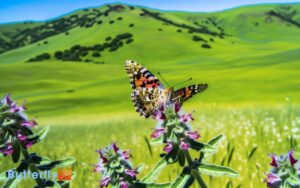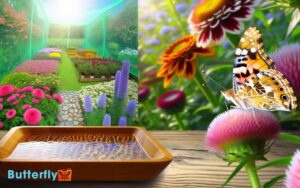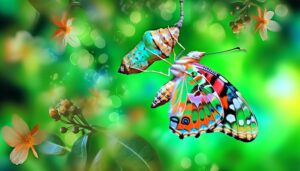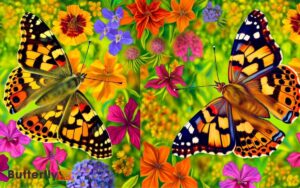Butterflies Similar to Painted Lady: Exploring Varieties!
Butterflies similar to the Painted Lady (Vanessa cardui) include the Red Admiral (Vanessa atalanta), distinguished by its red bands and white spots on the forewings, within the family Nymphalidae.
The American Lady (Vanessa virginiensis) and the West Coast Lady (Vanessa annabella) exhibit distinctive wing patterns and share migratory behaviors, similar habitats, and host plant preferences.
Additionally, the Monarch (Danaus plexippus) and Viceroy (Limenitis archippus) display comparable aposematic coloration and mimicry, enhancing their ecological adaptability.
Each species’ unique characteristics contribute to their fascinating biological and ecological profiles. Continue exploring to uncover more detailed insights on these butterflies.

Key Takeaways
Red Admiral
The Red Admiral (Vanessa atalanta), characterized by its distinctive red bands on dark wings, belongs to the family Nymphalidae and exhibits migratory behavior.
This species is part of the subfamily Nymphalinae, which encompasses butterflies known for their vivid coloration and diverse habitat range.
Vanessa atalanta’s forewings display striking red bands and white spots, aiding in species identification and camouflage. Its migratory patterns span across North America, Europe, and Asia, adapting to temperate climates.
Concerning taxonomy, the Red Admiral is closely related to other members of the genus Vanessa. Its larval host plants primarily include nettles (Urtica spp.), important for larval development.
This butterfly’s life cycle and migratory habits offer valuable insights into ecological adaptability and evolutionary biology.
American Lady
The American Lady (Vanessa virginiensis) exhibits distinctive wing patterns characterized by two large eyespots on the undersides of its hindwings. Its habitat spans a wide range, from meadows to urban gardens across North America.
Unlike the Painted Lady, the American Lady shows a preference for nectar from composite flowers and demonstrates unique migratory behaviors.
Distinctive Wing Patterns
Among the myriad of butterflies, the American Lady (Vanessa virginiensis) stands out due to its distinctive wing patterns, which feature a complex mosaic of orange, black, and white markings.
The forewings exhibit prominent orange patches bordered by black, accented with white spots. In contrast, the hindwings display intricate eyespots, providing a vital role in defense against predators.
| Wing Section | Distinctive Features |
|---|---|
| Forewings | Orange patches, black borders, white spots |
| Hindwings | Intricate eyespots, fine scaling |
| Underside | Brown with delicate, white lines |
| Margins | Wavy, black and white edges |
This detailed patterning not only aids in camouflage but also plays an essential role in mating and territorial behaviors, making the American Lady an engaging subject for lepidopterists.
Habitat and Range
Adaptability allows the American Lady to thrive in diverse habitats ranging from urban gardens to open fields and forest edges across North America.
This species, Vanessa virginiensis, exhibits a remarkable ability to colonize various environments, indicating its ecological plasticity.
Found throughout the United States, southern Canada, and Mexico, it prefers areas with abundant flowering plants. Urbanization hasn’t notably disrupted its range, as it exploits anthropogenic landscapes effectively.
The American Lady’s range extends to the Caribbean and parts of Central America, showcasing its wide geographical distribution.
Elevationally, it inhabits regions from sea level up to montane zones. This extensive range underscores the species’ flexibility in habitat selection, contributing to its successful proliferation across different biomes.
Behavior and Diet
American Lady butterflies, scientifically known as Vanessa virginiensis, exhibit diurnal behavior characterized by active foraging and territorial defense during daylight hours.
They mainly feed on nectar from a variety of flowering plants, including asters, goldenrods, and marigolds.
Larvae show a preference for host plants such as the cudweed (Gnaphalium spp.) and everlastings (Anaphalis spp.).
Adult females lay eggs singly on the upper surfaces of these host plants, ensuring a most suitable food source for the emerging caterpillars.
Vanessa virginiensis demonstrates territorial behavior, often engaging in aerial displays to ward off intruders. This species’ diet and behavior play crucial roles in their survival and reproductive success, highlighting their adaptation to varied ecological niches.
West Coast Lady
The West Coast Lady (Vanessa annabella) exhibits distinct morphological features that differentiate it from its close relatives within the Vanessa genus.
This species displays prominent black and orange coloration with a unique series of blue and white spots along the hindwings’ margins, which helps in its identification.
Unlike the Painted Lady, Vanessa annabella has four small eyespots on the underside of its hindwings. Its forewings possess a more angular shape, aiding in flight dynamics.
Taxonomically, Vanessa annabella falls under the Nymphalidae family and is predominantly located along the western regions of North America.
Their larvae primarily feed on mallow and hollyhock, distinguishing their ecological niche. These attributes collectively facilitate precise classification and understanding of their evolutionary adaptations.
Painted Lady Variations
Shifting focus to Painted Lady variations, Vanessa cardui exhibits remarkable phenotypic plasticity and widespread adaptability across diverse habitats.
This butterfly’s wing pattern and coloration can vary greatly depending on environmental factors such as temperature and photoperiod during development.
These variations enhance survival and reproductive success across its extensive range.
| Key Variations | Description |
|---|---|
| Wing Color | Ranges from vibrant orange to dull brown |
| Spot Patterns | Number and size of spots on forewings vary |
| Size | Wingspan ranges from 5 cm to 9 cm |
| Migration Patterns | Some populations migrate, others are sedentary |
| Larval Host Plants | Utilizes over 300 plant species |
These variations not only underscore the species’ adaptability but also contribute to its resilience in fluctuating climates and diverse ecosystems.
Monarch Butterfly
Renowned for its striking orange and black wing patterns, Danaus plexippus, commonly known as the Monarch butterfly, exhibits complex migratory behavior and a specialized reliance on milkweed plants for its larval stage.
This Lepidoptera species engages in a remarkable multi-generational migration, traveling thousands of miles from North America to central Mexico.
Monarchs possess aposematic coloration, warning predators of their toxicity derived from milkweed consumption.
Taxonomically, they belong to the family Nymphalidae, subfamily Danainae. Their developmental stages include egg, larva (caterpillar), pupa (chrysalis), and adult.
Monarchs face ecological threats such as habitat loss, climate change, and pesticide exposure. Conservation efforts focus on preserving milkweed habitats and migratory corridors, essential for their survival and reproduction.
Queen Butterfly
The Queen Butterfly (Danaus gilippus) inhabits tropical and subtropical regions, primarily found in the southern United States, Central America, and northern South America.
Exhibiting vibrant orange wings with black and white spots, it mimics the coloration pattern of the Monarch Butterfly.
Its behavior includes a preference for milkweed plants for oviposition and nectar feeding, similar to its close relatives in the Danaus genus.
Habitat and Range
Queen butterflies (Danaus gilippus) typically inhabit a wide range of environments, including open fields, gardens, and coastal regions throughout the southern United States, Central America, and parts of South America.
They thrive in habitats rich in milkweed (Asclepias spp.), which serves as their primary larval host plant. This dependency on milkweed is essential for their lifecycle, as females lay eggs on these plants, ensuring larvae have immediate access to food upon hatching.
Additionally, adult Queens are often found in areas abundant with nectar sources like Lantana and Verbena species.
Seasonal migrations also influence their range, with populations moving northward during warmer months and retreating to more temperate regions as temperatures drop, showcasing their adaptability to diverse climatic conditions.
Color and Patterns
Displaying a striking array of colors and patterns, Danaus gilippus features a distinctive reddish-orange hue with white spots on the forewings and black borders. The hindwings exhibit a solid orange color with black margins, creating a vivid contrast.
The ventral side of the wings, or the underside, reveals a subtler, paler orange with intricate white and black markings, aiding in camouflage.
Queen butterflies belong to the Nymphalidae family, sharing morphological traits with the Painted Lady. Their wing venation and scale arrangement are critical for identification.
The dorsal and ventral views of the wings, along with the unique pattern of spots and borders, play a significant role in thermoregulation and predator avoidance, marking Danaus gilippus as a visually captivating and ecologically significant species.
Behavior and Diet
Danaus gilippus exhibits a fascinating array of behaviors and dietary preferences that align closely with those of other Nymphalidae members.
Queen butterflies primarily consume nectar from various flowering plants, favoring those in the Asteraceae family. Their larvae feed on milkweeds (Asclepias spp.), absorbing toxic cardenolides, which provide chemical defense against predators.
Adults engage in basking behavior to thermoregulate, frequently seen spreading their wings in sunlight.
Males display territoriality, often patrolling specific areas and perching on vantage points to deter rivals. Additionally, they participate in ‘puddling,’ where they extract minerals and nutrients from moist soil.
This detailed analysis of Danaus gilippus‘ behavior and diet underscores the intricate ecological adaptations that enable their survival and reproductive success within diverse habitats.
Viceroy Butterfly
The Viceroy butterfly (Limenitis archippus), often mistaken for the Monarch, exhibits striking orange and black coloration with distinctive black lines crossing its hindwings.
This species provides a fascinating case of Batesian mimicry, where it imitates the Monarch (Danaus plexippus) to deter predators.
Taxonomically, the Viceroy belongs to the family Nymphalidae and subfamily Limenitidinae. Unlike the Monarch, the Viceroy’s larvae feed primarily on willow (Salix) and poplar (Populus) leaves.
The adult Viceroy frequents wet meadows and marshes, displaying a more localized habitat preference compared to the migratory Monarch.
Identification keys include a single black line traversing the hindwings, setting it apart from the Monarch. Understanding these distinctions aids in proper identification and appreciation of this remarkable butterfly.
Conclusion
In the grand tapestry of Lepidoptera, butterflies akin to the Painted Lady, such as the Red Admiral, American Lady, and West Coast Lady, exhibit fascinating variations. These species share similar migratory patterns, often traveling great distances in search of suitable habitats. Interestingly, scientists have even detected painted lady butterflies on radar, capturing their large-scale movements across continents. Such studies provide valuable insight into their navigation strategies and environmental adaptations.
Monarchs, Queens, and Viceroys, with their mimicry and distinct taxonomy, weave a complex narrative of evolution and adaptation.
These winged marvels, like characters in a Shakespearean play, reveal nature’s intricate designs, inviting us to explore further into the delicate balance of biodiversity and ecological interdependence.






